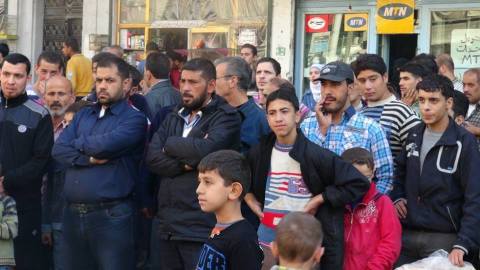The Syrian revolutionary movement that started in March 2011 has had to adapt its tools of resistance to the changing strategies of its oppressors. These include both the regime that has ruled the country for 50 years and those who are trying to use the vacuum left in the liberated areas to impose their own agendas. For more than two years now, demonstrations, banners, films, leaflets, graffiti and even street theatre have been used as a tool against torture, arrests, murder, shelling, and religious oppression. The Arab Dream theatre troupe is one such innovative form of resistance.
While it can be argued that it may be premature to attempt to try and critically assess the Syrian tragedy through art, especially when Syrian blood has not time to dry, the young artists behind the Arab Dream see it differently: “Art has a great role to play because it directly speaks to the audience’s subconscious. Art is also a way to show that this is not a nihilistic revolution devoid of ideas and visions, but on the contrary.”
The troupe, which is composed of eight young artists, has ventured out to do street theatre on the ground despite the omnipresent danger and the ongoing bombardment and clashes. This fearless attitude is based on a deep critical conviction in the organic relationship between art and resistance. They believe that their street theatre is
conditioned by the changing environment:
- As a way to develop the tools of resistance because “there is a new reality around us, and the traditional revolutionary tools of demonstrations are not effective in mobilizing and shaping public opinion, because the mass body of the population has been exhausted through bombing, hunger, destruction and exile.”
- The environment at the moment doesn’t allow for classical theatre work which has certain material prerequisites that are not available.
- The need for a cultural evolution, hand in hand with that of the uprising.

The troupe has insisted on using live street theatre in public place because they believe that those that are posted online have failed to reach their intended audience inside Syria. To that end, they have taken it upon themselves to deliver their art to the most crowded streets and public places in liberated areas, so as their message can reach the largest number of people. They have also decided to use silent plays as a more poignant suggestive form than dialogue and plot-based plays. The silent scenes also attract a larger number of spectators and deliver their message in the shortest amount of time.
The troupe’s first public event was likened by troupe’s members to their first demonstrations. However, their main fear was not the regime, but the Islamic State of Iraq and Syria (ISIS). The play which discussed the ongoing struggle between the Free Syrian Army (FSA) and ISIS and its effects on civilians, placed the troupe from its very beginnings in a clash with most of the radical Islamist military groups. ISIS attempted to ban the play on the basis that the music accompanying the show was religiously forbidden, but the troupe resisted and insisted that their show must go on.
https://www.youtube.com/watch?v=FHkzy6MiD3Q
This first confrontation has pushed the team to carefully select the public places for their events. According to an organizer, “we select the place based on its relevance to the subject topic of the play, but also based on how crowded it is. We also contact friends in the FSA and the coordination committees active in the town to be ready for any emergency.”
Despite the obstacles facing the team, including lack of funding and the unsafe working environment, the Arab Dream insists on continuing to represent the average Syrian, and to show its work to that same man on the street.



